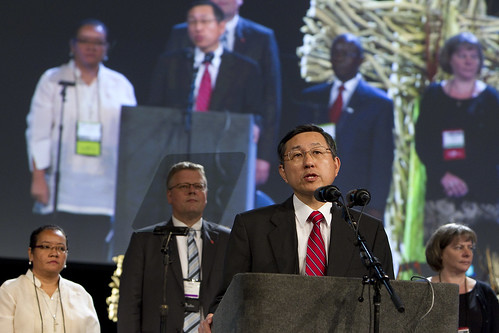GC2012: Covenant for a worldwide church debuts
A UMNS Report
By Skyler Nimmons*
5:30 P.M. April 26, 2012 | TAMPA, Fla.
 The Rev. Joon-Sik Park helps deliver a report from Committee to Study the Worldwide Nature of The United Methodist Church to the 2012 General Conference in Tampa, Fla. A UMNS photo by Mike DuBose. |
For more than 270 years, the Methodist movement has expanded and grown in almost every part of the world, including in the regions outside the United States that United Methodists call central conferences.
Recent growth is illustrated at the 2012 General Conference as, for the first time in the history of The United Methodist Church, more than 39 percent of the delegates are church members who live and worship in central conferences.
To better understand this growth and how the denomination will continue to be relevant, the 2004 and 2008 General Conferences commissioned the Committee to Study the Worldwide Nature of The United Methodist Church. During the last four years, the committee has examined how the church lives out the call of mission and ministry in all areas where a congregation is located.
General Conference delegates got their first look at the committee’s work on April 25 as they viewed a multimedia presentation with the theme of “Unified Vision and Unified Mission” and recited a liturgical covenant.
Profound words from John Wesley, the founder of the Methodist movement, graced the oversized screens around the Tampa Convention Center reading, “I look upon all the world as my parish.”
As the presentation continued, a diverse group of leaders shared what it might mean for the church to live out its true worldwide nature.
“When we listen to the church in different parts of the world, we learn that though we are separated by language and culture, we have so many things in common,” said Bishop Christian Alsted of the Nordic and Baltic Episcopal Area.
A global village with common purpose
“There was a time when being a part of a denomination was a far-away thing,” said Bishop Eben Nhiwatiwa of Zimbabwe. He noted that though the church’s connectional system is vast and the idea of the global church has been discussed for many years, full resource sharing and setting of church law have not been fully realized in many parts of Africa and Asia.
As the denomination continues to see decline in members in the United States, rethinking policies and structures seems to be a natural step to help the church thrive in all parts of the world.
“In this global village in which we are living we need to learn from each other. We cannot exist in a meaningful way in North Europe if we don’t have a clear perception of being a part of something greater, something that is worldwide,” said Alsted.
Backed by images of worship and praise from churches around the world, Bishop John Innis of Liberia said, “The worldwide nature of the church is a good concept, and I hope that it can be translated into reality.”
Central conferences provide a rich history and unique ministry and mission that often are not fully shared at General Conference, Bishop Patrick Streiff of Central and Southern Europe said. “We have to bring our experiences of what it means to have vital congregations, which can be enriching for many and the church in the U.S.,” he added.
Alsted said, “We have a common purpose. We have common experiences. We need to share those practices and experiences with each other if we want to be faithful in the purpose that Christ has called us to in making disciples of Jesus Christ for the transformation of the world.”
Vitality of the local church
As The United Methodist Church focuses on increasing the number of vital congregations around the world, many believe that the church’s connectional nature can help support this effort.
“I see a lot of vitality in our churches, and I hope that those who are alive because of the relationship of God through the Holy Sprit that they reach out to others because God inspires all of us,” said Bishop Rosemarie Wenner of Germany.
Bishop James Swanson of the Holston Area said, “Once again, I see a church that is proud to be United Methodist.”
“Unless we have the insight and the vision to press forward with something new and dynamic we might as well give up,” said Bishop Grant Hagiya of the Seattle Area.
The Rev. Ruby-Nell Estrella from the Philippines Annual (regional) Conference said, “We have many United Methodist churches in other parts of the world, and I believe our voices need to be heard.”
Covenant
The study committee hopes that the liturgical covenant will be placed in The Book of Discipline and used often in worship around the world to help the church move to a better understanding, greater self-respect and a deeper understanding of United Methodism’s global nature.
As the presentation ended, Alsted invited the almost 1,000 delegates to stand to recite the litany of the Covenant for a Worldwide United Methodist Church, which begins, “In covenant with God and with each other, we affirm our unity in Christ.”
Delegates responded, “We will take faithful steps to live more fully into what it means to be a worldwide church in mission for the transformation of the world.”
Conversations around the worldwide nature of the church study and the global United Methodist Church are continuing as delegates begin their work in legislative committees on April 26.
Read the study committee’s full report at www.worldwideumc.org.
*Nimmons is communications specialist for the Western North Carolina Annual (regional) Conference and a member of the United Methodist News Service team at General Conference.

Login/Register to leave comment